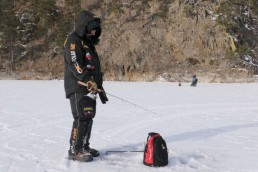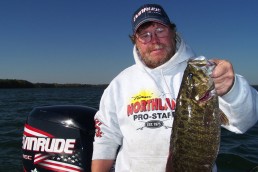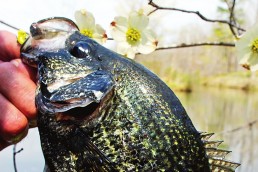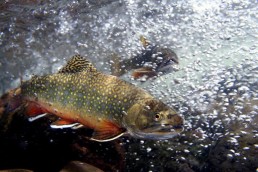When the Polar Vortex Attacks, Here’s how to Catch Fish
SHARE THIS POST
Whenever a winter season becomes significantly “influenced” by consistent weather events or ice anglers are faced with the extremes of the season, productivity is affected. Most experienced anglers understand the implications wrought by arctic cold fronts, but many aren’t sure how to effectively deal with them. And when a Polar Vortex comes cascading southward, the situation only becomes magnified. There’s no simple solution or magical formula for success on the ice in these situations, but those willing to brave the extremes and challenge themselves must consider many guidelines.
Maintain an open mind
Extreme conditions demand flexibility, versatility, and most importantly, an open mind. Don’t get locked into one single strategy without thinking each situation through. Instead, weigh your options carefully, beginning with the location. Thoughtfully consider all possibilities and pre-mark these designated locations, and then lock in their respective waypoints and be prepared to search. During these harsh conditions, fish will often congregate heavily, giving an all-new meaning to the phrase that “10 percent of the water holds 90 percent of the fish.” Properly handled and planned, you can then gain a distinct advantage. The trick is to be smart, efficient, and to pay close attention to all details while diligently working to determine precisely what is drawing in and concentrating the fish. Then, focus on these key locations and work them hard.
Lake type
When planning strategies, one of my primary considerations is lake type. A shallow, fertile, dark-water muck-bottomed lake might be red-hot during early ice, but when a Polar Vortex brings down dangerous temperatures and winds—especially on so-called dishpan-shaped lakes with minimal water movement that hold only a small volume of water overall—things can change quickly.
Once coated by an increasingly thick layer of ice topped with a heavy blanket of snow, any sunlight becomes blocked, leading to vegetation dying off. This suffocates the process of photosynthesis and eliminates oxygen production. That decaying matter also consumes free oxygen the fish use to breathe. As their environment is slowly depleted of this oxygen, stressed fish are forced to seek areas where adequate oxygen is available: a continually shrinking region that squeezes them into locations that are farther. Stressed, minimal feeding activity occurs, and when they’re pushed too far, these waters may even fail to provide enough oxygen for fish to survive, causing a condition called “winterkill.”
Obviously, these aren’t places where you want to spend time, let alone during a brutal cold front. To stay productive, I suggest focusing your efforts on reservoirs or bays of the Great Lakes where there are areas swept by refreshing currents. These flows of moving water help thwart excessively thick ice formation—at least in select locations—and regularly replenish oxygen concentrations, helping sustain aquatic life and keep fish moving.
Deeper lakes provide another viable option, as these higher-volume, less fertile waters typically maintain elevated oxygen counts. These waters freeze later in a normal winter, further helping to sustain higher oxygen levels, ensuring fish can move about and likely remain active even during extreme weather. Furthermore, there is evidence suggesting that fish holding in deeper waters aren’t influenced as heavily by high-pressure weather situations as their shallow-water living counterparts. Strong winter high pressure can have its affect on fish activity in reservoirs and deep lakes too, but those holding the greater volume of water or have areas swept by the fresh currents generally maintain a weather “resilience” for fish and provide an uptick in their activity. Because of this, the larger and deeper reservoirs and bays in the Great Lakes have become my favorite extreme-weather targets.
More locations
When on your chosen waters, be thorough. Remember, currents bring life-sustaining oxygen so search for structures in proximity to the main channel or the secondary feeder channels. I usually start on classic points against adjoining areas where channels cut close to shore. I begin my efforts shallow and gradually work deeper.
Should multiple shoreline points exist, diverse structures featuring distinct forms of cover might be better. And if you find fish and catch one or two, study your map again and go with the flow. Perhaps another point offers only standing timber or a healthy green weedline, but an interesting-looking inside turn may be there too. These diverse locations are often the most consistent producers. Keep working until you find the fish. The larger the concentration the better, and remember, vertically stacked, slightly suspended schools are more likely to be active than those positioned belly-tight to the bottom. Pay attention to the details, narrow down areas and pinpoint the specific patterns to avoid longer times out in the elements.
Presentation
Once fish are found, trigger them into striking. Given the harsh conditions, chances are good most won’t be actively feeding, but you still must figure out a way to make something happen. The best way to accomplish this is to settle in and get to work, and not just jump from hole to hole. When fish are active, the run-n-gun philosophy is great. But if they aren’t active, it’s usually better to settle in and wait them out.
My recommendation is a “one-two punch” that begins by lowering a light, small-scale presentation down on some sort of deadstick system—preferably one you don’t touch or one that generates minimal motion. This might involve simply setting a rod across an open 5-gallon bucket, placing it in an easily accessible rod holder, or, where legal, some sort of auto-hook set holder.
Are you enjoying this post?
You can be among the first to get the latest info on where to go, what to use and how to use it!
You don’t necessarily need live bait. When using innovative holders like HT’s Wind Jigger, plastic-tipped jigs, tentacle-graced tubes or spoons, you can become effective with the deadstick options. With Wind Jiggers, the strip steel will move ever so subtly in wind. Even simple footsteps on the floor of an ice shelter add slight, variable movements, and light taps on the strip steel produce fish-attracting vibrations that are hard to duplicate.
Once your secondary “sitter” line is established, try rigging a jigging combo with mid-sized motion baits. Don’t overdo it; this isn’t a time for giant oversized reactionary-type baits. Use medium-sized rattle spoons, jigging minnows, vibrating blades and lipless crankbaits. Any of these jigged gently while interspersed with sporadic rips or pops can draw a fish’s attention. You won’t necessarily catch many fish specifically on these baits in these weather conditions, but the activity can draw the fish in for a look, and close enough to bring them near your deadstick presentation, which can then trigger strikes.
Given the schools are heavily concentrated, this strategy can help turn on a few competitive individuals, allowing you to hook-up, even when others aren’t.
Subtle attractors
Added subtle attractors can also provide substantial rewards. Some great examples include smaller-sized metallic or colored flicker blades attached to a split ring at the head or tail of a spoon. These add variable hints of flash, color, motion and noise. Or use plastic creatures with thin-tail designs to add subtle wisps of motion and vibration that may turn tricks when little or nothing else will.
Another personal favorite are bits of fish scent-soaked yarn. This is a winter cold-front trick that can bring surprising results when facing adverse conditions in February.
Scent
Whether produced by the addition of small squirming grubs, tiny wriggling minnows, pinched off minnow heads, strips of cut bait or a variety of commercial scents, each may provide a competitive edge. Remember, when fishing finely balanced lures, commercial scents won’t negatively influence lure action.
Final details
Finally, you must prepare for spending extended time in extreme cold. Eat a hearty, warm breakfast, hydrate before heading out, and continue drinking plenty of water or juice, sports drinks, decaffeinated tea or coffee while you’re out where you fish. Supplement this by consuming heavy, slow-burning fats like warm soup or stew, beef jerky, donuts or chocolate bars or high-protein bars. Keeping your metabolism stoked ensures your body will continue burning calories and generating heat.
Of course, you must dress appropriately and cover all skin. Start with a moisture-wicking base layer from head to toe, loose-fitting socks, appropriately sized bibs, a waterproof and windproof coat, hats, gloves or mitts with temperature- and moisture-managing fabrics and a comfortable pair of well-insulated waterproof boots. Bring along hand warmers too and place activated ones in your mitts and pockets before leaving home. These convenient little packs offer comfort and provide warmth in the event your hands or fingers become chilled or wet after rigging soaked lines or when handling fish.
Tough conditions? Polar Vortex? Don’t quit. If you’re out there fighting these elements and have mental and physical toughness, you might as well be productive. Follow these strategies, prepare early and you will provide yourself with a solid start in any weather.
MWO
SHARE THIS POST
Did you enjoy this post?
You can be among the first to get the latest info on where to go, what to use and how to use it!
Tom Gruenwald
Tom Gruenwald has penned hundreds of informative ice-fishing articles and blogs, been a frequent and popular guest on outdoor speaking circuits, radio and television, has authored four ice-fishing books, and formerly hosted Tom Gruenwald Outdoors, a nationally syndicated television show dedicated solely to the sport of ice-fishing.



